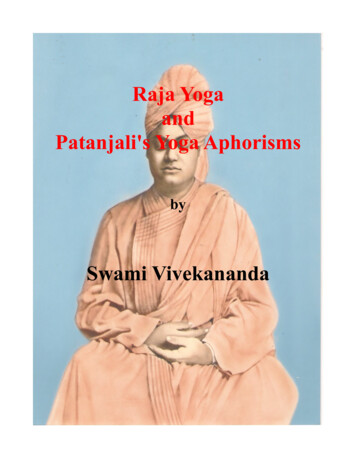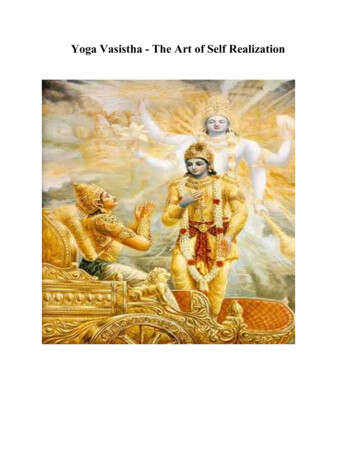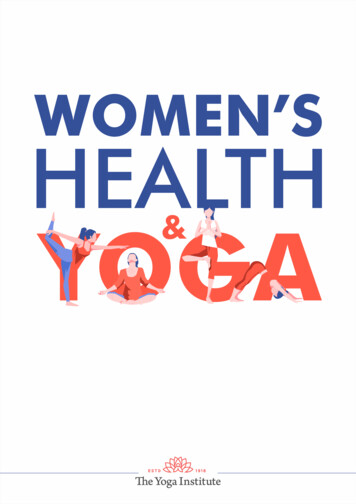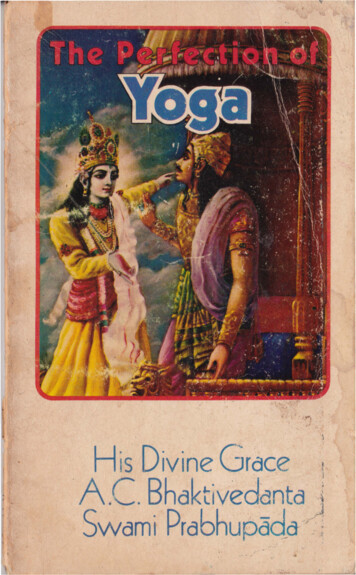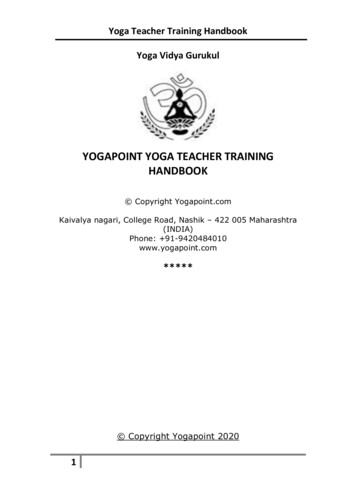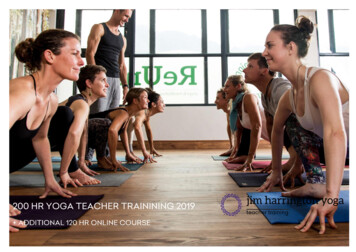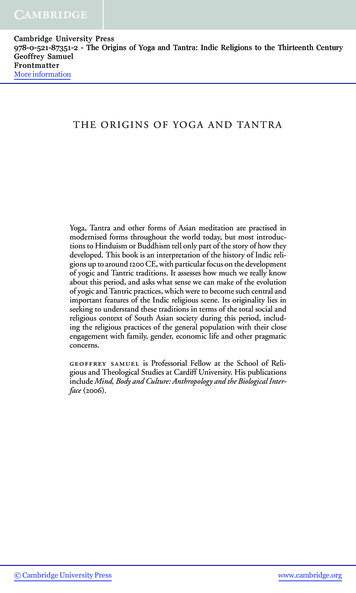
Transcription
Cambridge University Press978-0-521-87351-2 - The Origins of Yoga and Tantra: Indic Religions to the Thirteenth CenturyGeoffrey SamuelFrontmatterMore informationT H E O R I G I N S O F Y O G A A N D TA N T R AYoga, Tantra and other forms of Asian meditation are practised inmodernised forms throughout the world today, but most introductions to Hinduism or Buddhism tell only part of the story of how theydeveloped. This book is an interpretation of the history of Indic religions up to around 1200 CE, with particular focus on the developmentof yogic and Tantric traditions. It assesses how much we really knowabout this period, and asks what sense we can make of the evolutionof yogic and Tantric practices, which were to become such central andimportant features of the Indic religious scene. Its originality lies inseeking to understand these traditions in terms of the total social andreligious context of South Asian society during this period, including the religious practices of the general population with their closeengagement with family, gender, economic life and other pragmaticconcerns.g e o f f rey s a m u e l is Professorial Fellow at the School of Religious and Theological Studies at Cardiff University. His publicationsinclude Mind, Body and Culture: Anthropology and the Biological Interface (2006). Cambridge University Presswww.cambridge.org
Cambridge University Press978-0-521-87351-2 - The Origins of Yoga and Tantra: Indic Religions to the Thirteenth CenturyGeoffrey SamuelFrontmatterMore informationT H E O R I G I N S O F YO G AA N D TA N T R AIndic Religions to the Thirteenth CenturyG E O F F R E Y SA M U E L Cambridge University Presswww.cambridge.org
Cambridge University Press978-0-521-87351-2 - The Origins of Yoga and Tantra: Indic Religions to the Thirteenth CenturyGeoffrey SamuelFrontmatterMore informationc a m b r i d g e u n i ve r s i t y p re s sCambridge, New York, Melbourne, Madrid, Cape Town, Singapore, São Paulo, DelhiCambridge University PressThe Edinburgh Building, Cambridge cb2 8ru, UKPublished in the United States of America by Cambridge University Press, New Yorkwww.cambridge.orgInformation on this title: www.cambridge.org/9780521695343 c Geoffrey Samuel 2008This publication is in copyright. Subject to statutory exceptionand to the provisions of relevant collective licensing agreements,no reproduction of any part may take place withoutthe written permission of Cambridge University Press.First published 2008Printed in the United Kingdom at the University Press, CambridgeA catalogue record for this publication is available from the British LibraryLibrary of Congress Cataloging-in-Publication DataSamuel, Geoffrey.The origins of yoga and tantra: Indic religions to the thirteenth century /Geoffrey Samuel.p. cm.Includes bibliographical references and index.isbn 978-0-521-87351-2 (hardback) – isbn 978-0-521-69534-3 (pbk.)1. India–Religion. 2. Yoga–History. 3. Tantrism–History. I. Title.bl2005.s26 2008294.09 01–dc222007046053isbn 978-0-521-87351-2 hardbackisbn 978-0-521-69534-3 paperbackCambridge University Press has no responsibility for the persistence oraccuracy of URLs for external or third-party internet websites referred toin this publication, and does not guarantee that any content on suchwebsites is, or will remain, accurate or appropriate. Cambridge University Presswww.cambridge.org
Cambridge University Press978-0-521-87351-2 - The Origins of Yoga and Tantra: Indic Religions to the Thirteenth CenturyGeoffrey SamuelFrontmatterMore informationContentsList of figuresPrefacepage viix1 Introduction12 Stories and sources15pa rt o n e m e d i tat i o n a n d yo g a393 The Second Urbanisation of South Asia414 Two worlds and their interactions615 Religion in the early states946 The origins of the Buddhist and Jaina orders1197 The Brahmanical alternative1538 Interlude: Asceticism and celibacy in Indic religions173pa rt t wo ta n t r a1919 The classical synthesis19310 Tantra and the wild goddesses22911 Subtle bodies, longevity and internal alchemy27112 Tantra and the state29113 The later history of yoga and Tantra32414 Postlude339ReferencesIndex354402v Cambridge University Presswww.cambridge.org
Cambridge University Press978-0-521-87351-2 - The Origins of Yoga and Tantra: Indic Religions to the Thirteenth CenturyGeoffrey SamuelFrontmatterMore informationFigures1.1. ‘Proto-Śiva’ Seal (M-304, after Parpola 1994: 188)1.2. Seal Mohenjo-Daro M-1186 (after Parpola 1994: 260,Fig. 14.35)3.1. Map: Painted Grey Ware and Northern Black PolishedWare (after Schwartzberg’s Historical Atlas of South Asia)3.2. Map: Areas of Early Urbanisation (after Allchin)3.3. Map: The Mahājanapadas (after Schwartzberg)3.4. Map: Nanda and Mauryan states (after Schwartzberg)4.1. Map: The Two Worlds (c. 500 BCE)4.2. The Candravam. śa (Lunar Dynasty): Outline Diagram4.3. The Sūryavam. śa (Solar Dynasty) and the Kings ofMithilā: Outline Diagram4.4. The Early South Indian Caste System according toGeorge Hart4.5. The Brahmanical Varn.a System5.1. Unidentified Yaks.a. Vidisha Museum (photo by author)5.2. Indra disguised as a woodcutter offers grass to Śākyamuni(accompanied by Vajrapān.i), Gandhara, 1st cent CE,Peshawar Museum (photo by Sylvia Sax)5.3. Vaiśravan.a. Modern Tibetan wall-painting, TongsaGompa, Kalimpong (photo by author)5.4. Gajalaks.mı̄ on Stūpa 2, Bharhut Stūpa, Indian Museum,Calcutta (photo by author)6.1. Śākyamuni prior to his enlightenment (accompanied byVajrapān.i) consults a jat.ila Brahmin. Gandhara, late firstcentury CE, Peshawar Museum (photo by Sylvia Sax)6.2. Stūpa as depicted on Bharhut Stūpa, Indian Museum,Calcutta (photo by author)page 45444657596265668687103105106108121141vi Cambridge University Presswww.cambridge.org
Cambridge University Press978-0-521-87351-2 - The Origins of Yoga and Tantra: Indic Religions to the Thirteenth CenturyGeoffrey SamuelFrontmatterMore informationList of figures6.3. Two Deities. Bharhut Stūpa, Indian Museum, Calcutta(photo by author)6.4. Tambiah’s Diagram of the Value System of NortheastThai Village Society (Tambiah 1970: 338)7.1. Veena Das’s Diagram of the Value System of IndianSociety9.1. Map of Kus.ān.a and Sātavāhana States, first to thirdcenturies CE (after Schwartzberg)9.2. Map of Gupta, Vākāt.aka and Pallava States, fourth tosixth centuries CE (after Schwartzberg)9.3. Early states in SE Asia to c. 650 CE (after Schwartzberg)9.4. Anointing of Kumāra as Divine General (India, GuptaPeriod) (photo from Theresa McCullough)10.1. Bhairava, Vidisha Museum (photo by author)10.2. Cakreśvarı̄. Mount Abu (photo by author, 1972.)10.3. Guhyasamāja, probably 16th century, VajrabhairavaTemple, Tsaparang, Western Tibet (photo by RobLinrothe)10.4. Hevajra. Abu Cave, Piyang, Western Tibet, probably17th or 18th century (photo by Rob Linrothe)11.1. Meditator with Cakras and Kun.d.alinı̄ (Wellcome Library,Sanskrit & Prakrit MSS No.640)12.1. Map of South Asia, eighth to tenth centuries(after Schwartzberg)12.2. Map of Southeast Asia, eighth to tenth centuries(after Schwartzberg)12.3. (left to right). Indrayān.ı̄, Brahmayān.ı̄, Cāmun.d.ā(from Vergati 2000) (photos by Suzanne Held)12.4. ’Cham dancer at Zangs mdog dpal ri dgon pa, Kalimpong(photo by author)12.5. Bhuta dancer, South Kanara District (photo by MarkNichter) Cambridge University 316318320www.cambridge.org
Cambridge University Press978-0-521-87351-2 - The Origins of Yoga and Tantra: Indic Religions to the Thirteenth CenturyGeoffrey SamuelFrontmatterMore informationPrefaceThis book is based on the Wilde Lectures in Natural and ComparativeReligion, which I delivered at the University of Oxford in November andDecember 2002 under the title ‘Indic religions to 1200 AD: a critical andanthropological approach’. Those who were present at the lectures willrealise that this book differs from the lectures in other respects besides thetitle. Most of the text of the lectures is here, in one form or another, but Ihave taken the opportunity to rethink and extend the argument in manyplaces. Unfortunately, the extensive visual material presented in the lectureshas had for practical reasons mostly to be excluded from the book.This is a relatively short book, however, on a very large subject, andthere has been no attempt to be comprehensive. The book focuses onthe development of the yogic and Tantric tradition in Indic societies, andwhile I have discussed the wider context in which these events happenedin considerable detail, I have not attempted to provide a comprehensivehistory of Indian religion.It is difficult to deal with language transcription consistently and systematically in a book that ranges over several bodies of scholarly literatures withdifferent conventions. The omission of diacritics is nevertheless a major irritant and often deprives the reader of vital information, quite apart fromrendering it impossible to know how words might be pronounced. Mygeneral strategy has been to give only modern place names and words thatare thoroughly Anglicised without diacritics. I have generally given Sanskritforms in preference to Pali or other Prakrits, though have employed thelatter in contexts where it would seem clumsy or inappropriate to do otherwise (e.g. when I am citing the Pali Canon). I beg the reader’s indulgencefor remaining errors and inconsistencies; I am not a Sanskritist.I wish to express my appreciation to the Electors of the Wilde Lecturesfor allowing me to give the lectures, and in particular to Richard Gombrich,who was a most kind and gracious host during my stay in Oxford, as indeedduring my previous stay in 1999, and who helped me in very many respectsix Cambridge University Presswww.cambridge.org
Cambridge University Press978-0-521-87351-2 - The Origins of Yoga and Tantra: Indic Religions to the Thirteenth CenturyGeoffrey SamuelFrontmatterMore informationxPrefacein relation to this book. I would also wish to thank those who attendedthe lectures and provided valuable discussion and insight, and to manyothers with whom I have discussed some or all of these issues in recentyears. The list is a long one, but I wish to mention at least Naman Ahuja,Nick Allen, Robert Beer, Jim Benson, Marieke Clarke, Lance Cousins,Max Deeg, Gill Farrer-Halls, Gavin Flood, Will Tuladhar-Douglas, DavidGellner, Sanjukta Gupta, Adam Hardy, James Hegarty, Saunaka Rishi Das,Will Johnson, Klemens Karlsson, Kim Chong-Ho, Elizabeth de Michelis,Mogg and Kym Morgan, Ruth Rickard, Rob Mayer, Cathy Cantwell, BrianBocking, Kate Crosby, Brenda McGregor, Ted Proferes, Robert Pryde, JuliaShaw, Andrew Skilton and Michael Willis. I apologise to others whom Ihave undoubtedly omitted. I particularly thank Thomas J. Hopkins for hisgraciousness in allowing me to read and refer to his unpublished work onthe early history of Indian religions, Gunnar Haaland for allowing me touse a photograph of a thang-ka in his possession for the cover, and RobLinrothe, Theresa McCullough, Mark Nichter, Asko Parpola, Sylvia Saxand Anne Vergati for providing photographs and for assistance in obtainingpermission to use photographs. I also thank the National Museum of India,the Department of Archaeology and Museums, Government of Pakistan,for permission to use images and Peshawar Museum, Vidisha Museum, andthe Indian Museum, Calcutta for permission to photograph objects in theircollections. I thank Kate Brett and Gillian Dadd, of Cambridge UniversityPress, for their friendly, helpful and efficient assistance with producing thebook.I also thank the University of Newcastle, New South Wales for allowingme to undertake two periods of study leave during which much of theresearch for the book was undertaken, the Leverhulme Trust and BrianBocking for a visiting professorship at the School of Oriental and AfricanStudies in 2003–4 which gave time for valuable further work on this project,and Cardiff University for appointing me to the Professorial Fellowshipwhich has allowed its completion. I also wish to acknowledge the participants in the May 2004 workshop at SOAS on the politics of Asian religions,among them Saunaka Rishi Das, Madhu Kishwar, Rajiv Malhotra, HirokoKawanami, Chakraborty Ram Prasad and Ursula King, who helped greatlyin formulating some of the ideas in Chapter 1 and elsewhere in the book. Ido not think that at this point in time there is any fully satisfactory answerto the questions raised on that occasion, but I hope that this book will bein its way a positive contribution to the ends towards which that workshopwas directed. Cambridge University Presswww.cambridge.org
THE ORIGINS OF YOGA AND TANTRA Yoga, Tantra and other forms of Asian meditation are practised in modernised forms throughout the world today, but most introduc-tions to Hinduism or Buddhism tell only part of the story of how they developed. This book




